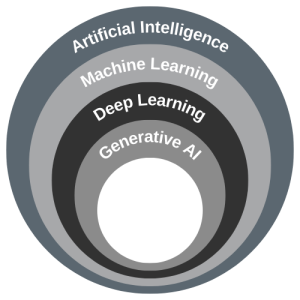An Introduction to the AI in Education: Shaping Future Classrooms Conference Companion
Chris D. Craig and Robin Kay
Introduction
Have you ever been curious about how we think and learn? It is a timeless question that led to the development of artificial intelligence (AI) through science and engineering research following World War II (McCarthy, 2007; Russell & Norvig, 2010). However, it was not until the emergent access to and increased usability of AI in 2022 that the technology now permeates the general public consciousness—including those of our K-12 administrators, educators, and students (Bender, 2024; Diliberti et al., 2024; Perrault & Clark, 2024). Following along with colloquial discussions that often focused on AI and academic dishonesty, we recognized that an opportunity needed to exist for more diverse viewpoints.
Building from the reflection, we decided to provide an opportunity for educational professionals with varying roles and geographic locations to share the benefits and challenges of their experiences and outlooks with their peers. As a result, we are proud to share an overview of the insights from three nights and 27 hours of presentations at the AI in Education: Shaping Future Classrooms Conference. The following two sections provide expanded insight and concise presentation accompaniments from our esteemed educators. Each chapter is readily easily accessible and:
- Outlines general themes and the target audience;
- Provides an overview of the topic or tool;
- Activities to inspire you or to try yourself, and
- Support materials to further explore the evolving landscape of educational technology and AI.
The remainder of this chapter is a primer, outlining AI in a historical context within society and education.
The Emergence of AI
Inspired by the concept of how we think and learn and building from earlier works of classical scholars such as Thomas Bayes, Charles Babbage, and Nikola Tesla—who respectively contributed Bayesian inference, the analytical engine, and the concept of a machine’s own mind—Alan Turing exerted notable influence in the early development of AI when he reenvisioned the question into: Can machines think? (Meacham, 2021; Russell & Norvig, 2010; Tesla, 1900; Turing, 1950). Soon after, in 1956, John McCarthy was credited with providing the general definition of AI, and while others exist, it is influential (Russell & Norvig, 2010).
Where intelligence refers to the computational aspect of goal achievement, McCarthy (2007) defines AI as:
The science and engineering of making intelligent machines, especially intelligent computer programs. It is related to the similar task of using computers to understand human intelligence, but AI does not have to confine itself to methods that are biologically observable. (p. 2)
The following 70 years saw AI become an embedded part of everyday life. For example, an AI tool entitled “Mal” was recently used in the development of a new Beatles song, and we encounter it regularly through financial services, healthcare, video games, chatbots, online recommendations, security technologies, and email (Kennedy et al., 2023; Russell & Norvig, 2010; Savage, 2023; Sullivan, 2023). Following iterative design processes and technological diffusion, the broad term AI has developed various AI subsets, as represented by a Venn diagram in Figure 1, and outlined below.
Figure 1
Nested AI Subsets

-
One notable aspect is machine learning, which uses statistical methods to improve outputs and goals—for example, viewing recommendations on Netflix—with increasing accuracy (Aggarwal et al., 2022; Manning, 2020; Sajja, 2021).
-
Within machine learning, neural networks refer to using interconnected nodes inspired by human neurons to classify and cluster information (Aggarwal et al., 2022; Manning, 2020; Sajja, 2021).
-
As a subset of machine learning, deep learning uses hierarchical neural network layers to model data such as facial recognition in a manner inspired by the human brain.
-
Generative AI is another subset that has received a lot of recent media attention (e.g., OpenAI’s Chat GPT or Google’s Gemini) and is a subset of deep learning which creates digital relics through the influence of pre-existing artifacts to create audio, images, text, and video (Baidoo-Anu & Ansah, 2023; SAS Institute, n.d.).
-
Other common examples include Expert Systems, Natural Learning Processes, and Machine Vision (Collins et al., 2021).
Recognizing that AI’s underlying processes and classifications are technical, diverse, and often challenging to classify, two generally referenced types include narrow and general (Aggarwal et al., 2022; Wang, 2019). Narrow AI refers to our common systems with a singular high-proficiency task focus, such as autonomous vehicles or digital assistants (Aggarwal et al., 2022; Manning, 2020). Next, General AI is a concept that refers to systems with context awareness modelled after a human’s ability to adapt to diverse situations (Sajja, 2021). While General AI is not yet a reality, an example of a technology approaching general intelligence is OpenAI’s ChatGPT (Wu et al., 2023).
Artificial Intelligence in Education
As AI is now a part of many aspects of our society, our formal education systems seek to integrate technology to support diverse stakeholders such as administrators, teachers, and students. Intending to foster adaptive and interactive learning environments, the cross-disciplinary research of Artificial Intelligence in Education involves psychology, computer science, and education (Doroudi, 2022). Additionally, the cross-disciplinary approach seeks to support learning by offering computationally precise and explicit knowledge to encourage learners to gain a deep and finely tuned understanding of the learning process and their own learning (Luckin et al., 2016). While educational structures constantly face challenges due to emergent digital technologies—for example, the calculator, computers, the internet, and cell phones (Banks, 2008; Bates, 2019; Christensen, 2010)—AI provides a unique opportunity to personalize learning and reinvent our modern structures to address pervasive challenges such as access to learning materials and personalized guidance that can limit student learning (Luckin et al., 2016; Miao et al., 2021).
As the new AI affordances continue to grow, reflecting on its potential role, or roles, as an educational tool can be useful for discourse. To help outline the different roles, Ouyang and Jiao (2021) conducted a systematic summary, which resulted in three paradigms:
- AI-directed refers to the learner-as-recipient and involves AI being used to direct cognitive learning;
- AI-supported considers the learner as a collaborator with an instrument’s AI components; and
- AI-empowered positions the learner as a leader in the interaction.
The following chapters reflect each paradigm at differing levels and key themes, including AI literacy, subject areas, ethical issues, tools, and learning in a K-12 environment.
Resources
For a more extensive exploration of:
- The evolution and integration of AI into our everyday lives, review Shadbolts’ (2022) article “From So Simple a Beginning: Species of Artificial Intelligence;”
- Perspectives on AI and educational policy, review
References
Aggarwal, K., Mijwil, M. M., Al-Mistarehi, A. H., Alomari, S., Gök, M., Alaabdin, A. M. Z., & Abdulrhman, S. H. (2022). Has the future started? The current growth of artificial intelligence, machine learning, and deep learning. Iraqi Journal for Computer Science and Mathematics, 3(1), 115-123. https://doi.org/10.52866/ijcsm.2022.01.01.013
Baidoo-Anu, D., & Ansah, L. O. (2023). Education in the era of generative artificial intelligence (AI): Understanding the potential benefits of ChatGPT in promoting teaching and learning. Journal of AI, 7(1), 52-62. https://doi.org/10.61969/jai.1337500
Banks, S. (2011). A historical analysis of attitudes toward the use of calculators in junior high and high school math classrooms in the United States since 1975 [Masters dissertation, Cedarville University]. ERIC. https://files.eric.ed.gov/fulltext/ED525547.pdf
Bates, A. W. (2019). A short history of educational technology. In, Teaching in a Digital Age (2nd ed.). Tony Bates Associates Ltd. https://pressbooks.bccampus.ca/teachinginadigitalagev2/chapter/section-8-1-a-short-history-of-educational-technology/
Bender, S. M. (2024). Awareness of artificial intelligence as an essential digital literacy: ChatGPT and Gen-AI in the classroom. Changing English, 31(2), 161-174. https://doi.org/10.1080/1358684X.2024.2309995
Christensen, C. (2010). Disrupting class, expanded edition: How disruptive innovation will change the way the world learns. McGraw Hill.
Collins, C., Dennehy, D., Conboy, K., & Mikalef, P. (2021). Artificial intelligence in information systems research: A systematic literature review and research agenda. International Journal of Information Management, 60, Article 102383. https://doi.org/10.1016/j.ijinfomgt.2021.102383
Diliberti, M. K., Schwartz, H. L., Doan, S., Shapiro, A., Rainey, L. R., & Lake, R. J. (2024, April 17). Using artificial intelligence tools in K–12 classrooms [Document #RR-A956-21]. RAND Corporation. https://doi.org/10.7249/RRA956-21
Doroudi, S. (2022). The intertwined histories of artificial intelligence and education. International Journal of Artificial Intelligence in Education, 33, 885-928. https://doi.org/10.1007/s40593-022-00313-2
Kennedy, B., Tyson, A., & Saks, E. (2023, February 15). Public awareness of artificial intelligence in everyday activities. Pew Research Center. https://www.pewresearch.org/science/2023/02/15/public-awareness-of-artificial-intelligence-in-everyday-activities/
Luckin, R., Holmes, W., Griffiths, M., & Forcier, L. B. (2016). Intelligence unleashed: An argument for AI in education. Pearson. https://oro.open.ac.uk/50104/
McCarthy, J. (2007, November 12). What is artificial intelligence?. Stanford University: Project JMC. https://www-formal.stanford.edu/jmc/whatisai.pdf
Manning, C. (2020, August). Artificial intelligence definitions. Stanford University: Human-Centered Artificial Intelligence. https://hai.stanford.edu/sites/default/files/2020-09/AI-Definitions-HAI.pdf
Miao, F., Holmes, W., Huang, R., & Zhang, H. (2021). AI and education: A guidance for policymakers. UNESCO Publishing. https://doi.org/10.54675/PCSP7350
Meacham, M. (2021). A brief history of AI and education. International Journal of Adult and Non Formal Education, 2(4), 1-2. https://www.globalscienceresearchjournals.org/articles/a-brief-history-of-ai-and-education.pdf
Ouyang, F., & Jiao, P. (2021). Artificial intelligence in education: The three paradigms. Computers and Education: Artificial Intelligence, 2, Article#100020. https://doi.org/10.1016/j.caeai.2021.100020
Perrault, R., & Clark, J. (2024). Artificial Intelligence Index Report 2024. Stanford University, Human-Centered Artificial Intelligence. Retrieved May 2024, from https://aiindex.stanford.edu/report/
Russell, S. J., & Norvig, P. (2010). Artificial intelligence: A modern approach (3d ed.). Prentice Hall.
Sajja, P. S. (2021). Introduction to artificial intelligence. In, Illustrated computational intelligence: Examples and applications (pp. 1-25). Springer Singapore. https://doi.org/10.1007/978-981-15-9589-9_1
SAS Institute. (n.d.). Artificial intelligence: What it is and why it matters. Retrieved May 2024, from https://www.sas.com/en_ca/insights/analytics/what-is-artificial-intelligence.html
Savage, M. (2023, June 13). Sir Paul McCartney says artificial intelligence has enabled a ‘final’ Beatles song. BBC News. https://www.bbc.com/news/entertainment-arts-65881813
Sullivan, W. (2023). The Beatles release their last song, ‘Now and Then,’ featuring A.I.-extracted vocals from John Lennon. Smithsonian Magazine. Retrieved May 2024, from https://www.smithsonianmag.com/smart-news/the-beatles-release-their-last-song-now-and-then-ai-john-lennon-180983188/
Shadbolt, N. (2022). “From So Simple a Beginning”: Species of Artificial Intelligence. Daedalus, 151(2), 28-42. https://www.amacad.org/publication/so-simple-beginning-species-artificial-intelligence
Tesla, N. (1900, June 01). The problem of increasing human energy. Century Magazine, 175-211. https://archive.org/details/problemofincreas0000tesl/mode/2up
Wu, T., He, S., Liu, J., Sun, S., Liu, K., Han, Q. L., & Tang, Y. (2023). A brief overview of ChatGPT: The history, status quo and potential future development. IEEE/CAA Journal of Automatica Sinica, 10(5), 1122-1136. https://doi.org/10.1109/JAS.2023.123618



